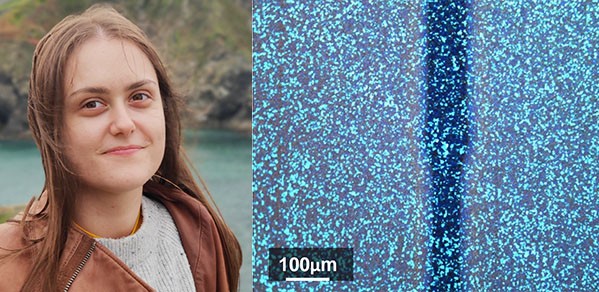
Oana Niculescu’s PhD research is aiming to improve upon solutions to an age-old problem faced by astronomers: how to correct telescope images distorted by the Earth’s atmosphere.
Using liquid crystals is cheaper, provides longer lifespans due to the lack of moving parts, and can be made to higher resolutions (as we can see from modern display technology such as televisions and smartphones).
Oana Niculescu
Oana is investigating the application of liquid crystals as the medium of correction, rather than the tried-and-tested deformable mirror, and it is this ongoing research that has won her a 2023 CAPE Acorn Postgraduate Research Award (CAPA). The Award, presented by the Centre for Advanced Photonics and Electronics (CAPE), is in recognition of her project titled Blue Phase Liquid Crystal Phase Modulators For Astronomical Adaptive Optics.
Astronomical observation from Earth is hindered by having to look through the atmosphere. Small changes in temperature and wind velocity add a distortion to any image that astronomers try to take. This problem has been solved over the years by using purpose-built sensors to measure the aberration that the atmosphere introduces, before correcting it with a deformable mirror – an adaptive element that changes shape to invert the effect of this distortion.
“This works very well, but it is costly to produce a mirror that has a smooth surface and can change its shape at the rate at which the atmosphere changes its properties – about 1,000 times per second,” says Oana. “This is where I come in, with my intention to use liquid crystals as the medium of correction rather than a mirror.”

A diagram showing the functionality of an adaptive optics system, with Oana's blue phase device acting as a correcting element. Credit: Oana Niculescu.
Liquid crystals are a versatile material used in light beam manipulation and much progress has been made in using the material in adaptive optics. But there are still some challenges that require even better fabrication techniques. What hasn’t been attempted so far in astronomy, says Oana, is using liquid crystal devices that can reach kilohertz refresh rates (the number of times per second the device can predictably affect light coming from the telescope) in order to provide a distortion-free image.
“I aim to use the blue phase of liquid crystals, which have a complex structure that is only stable over a very short temperature range (less than 1ºC), but can be increased by polymerisation (a process by which the said structure is 'fixed' into place) to work over a range of about 40ºC.
“This is a fiddly process, but using liquid crystals is cheaper, provides longer lifespans due to the lack of moving parts, and can be made to higher resolutions (as we can see from modern display technology such as televisions and smartphones).”
“This would by no means be the be-all and end-all of the improvement of Earth-based telescopes, but it would provide an alternative, and could be much more attractive to the amateur astronomer attempting to take pictures of the night sky,” she added.
About Oana Niculescu
Oana is part of the Centre of Molecular Materials for Photonics and Electronics (CMMPE) research group. Her PhD is titled Liquid Crystal Adaptive Optics System for Ground-Based Telescopes.
For her Master of Research (MRes) degree, Oana completed two projects under the Connected Electronic and Photonic Systems programme at Cambridge. These were:
- Nanophotonics for enhancing optical absorptions in optoelectronic devices
- Liquid crystal lenses for head-up displays in automotive applications.

